Research
October 07, 2025
Consumer outlook
Key driver of consumer activity is losing momentum
The robust labor market that has powered the current consumer-driven economic expansion is showing some cracks. The economy added just 107,000 net new jobs between May and August, which was less than a quarter of the jobs added during the first four months of 2025.
On the positive side, the national unemployment rate remains low by historical standards and there hasn’t been a significant uptick in layoffs. Still, the recent deterioration of job growth is a warning sign that a key driver of consumer activity may be losing steam.
It’s not just a slowing labor market that will test consumers’ resilience. Rising debt levels – along with an uptick in delinquency rates – will limit the ability of many households to keep spending. At the same time, household wealth keeps soaring to record levels, which will continue to buoy the confidence of consumers with homes and investments.
This story of the bifurcated consumer is nothing new, and will remain in place as the calendar flips to 2026.
As long as the economy continues to grow – which remains our base case for 2026 – consumers on the aggregate will likely have the financial wherewithal to support their spending.
This article presents the latest trends in key indicators that impact consumers’ ability and willingness to spend. Visit this page throughout the year for ongoing analysis of the state of the American consumer.
Consumer confidence remains dampened
Even before the recent slowdown in the labor market, The Conference Board’s Consumer Confidence Index showed signs of rising economic uncertainty among households. This measure of consumer sentiment declined in five consecutive months (December 2024 to April 2025) – settling at its lowest level since April 2020. That was largely due to declines in the expectations component of the index, which measures consumers’ short-term outlook for income, business, and labor market conditions. Although consumer confidence rebounded somewhat from the April low point, the index remains well below its readings at the beginning of the year. Not surprisingly, consumers on the lower end of the income scale are much less confident in the direction of the economy.
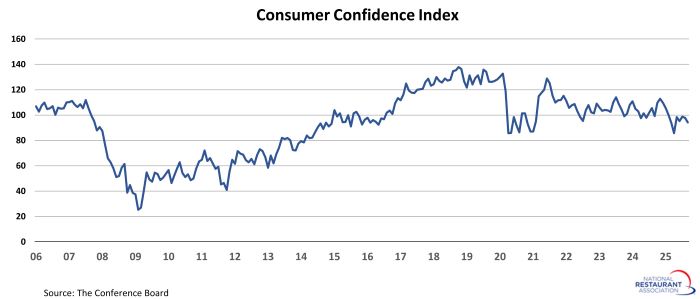
Job growth slowed significantly in recent months
Employment growth slowed to a crawl in recent months, amid rising levels of uncertainty. The economy added an average of just 27,000 jobs during the 4-month period from May to August – including a net loss of 13,000 jobs in June. That was well below the average monthly gain of 123,000 jobs during the first 4 months of 2025, and represented the weakest period of job growth since 2020.
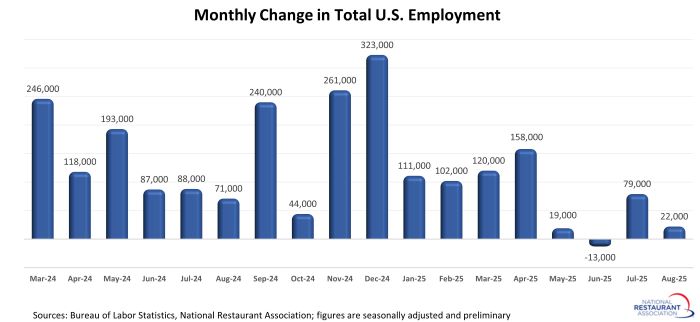
Wage growth is slowing but remains above historical averages
Job growth slowed significantly in recent months, but wage growth remained relatively solid. Average hourly earnings of private sector employees increased 3.7% between August 2024 and August 2025. That was 2 percentage points below the strong gains posted during 2022, but still remained above the 3.3% average gain during 2019.
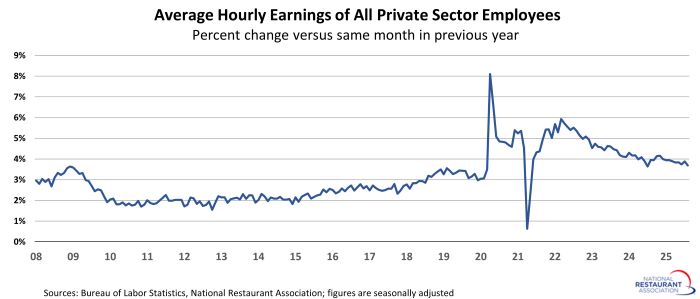
Savings rate dipped below pre-pandemic levels
Household savings soared during the first year and a half of the pandemic, driven primarily by reduced consumer activity as well as income-supporting fiscal stimulus packages. Many households used these excess savings to support elevated spending levels, which blunted the impact of soaring inflation. Savings rates are now below pre-pandemic levels, which means the financial cushion that many households established during the pandemic is largely depleted.
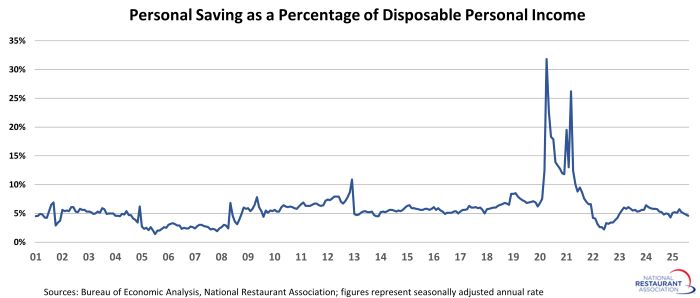
Household wealth surged in the second quarter
Household wealth declined in the first quarter of 2025, due largely to a dip in the stock market. The 1.0% decline (or $1.7 trillion) followed five consecutive quarterly gains, during which total household net worth rose by more than $18 trillion. The first quarter’s decline was more than erased in the second quarter, with household wealth surging by 4.2% – or $7.1 trillion. In dollar terms, that represented the largest quarterly increase since the fourth quarter of 2020 (+$8.2 trillion).
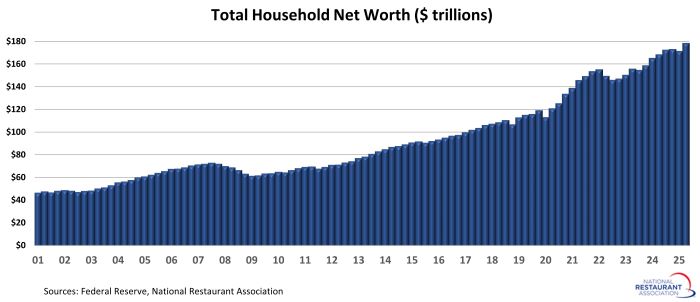
Household debt continues to rise
Household debt trended steadily higher in recent years, with aggregate balances reaching $18.4 trillion by 2025:Q2. That was $4.2 trillion higher than the 2019:Q4 level. Mortgages represent the bulk of household debt at 70%, followed by auto loans (9%) and student loans (9%).
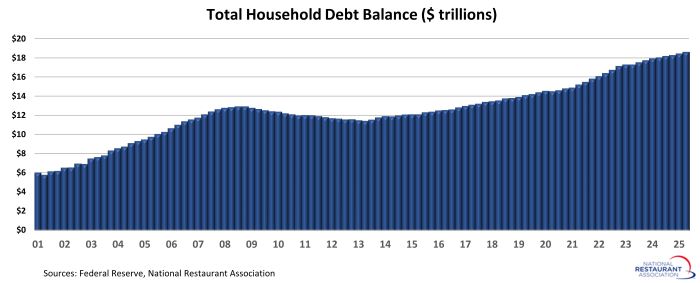
Revolving credit levels continue to rise
Consumer credit balances fell to a 4-year low during the early months of the pandemic – primarily because households had fewer places to spend their money. That trend quickly reversed as restrictions eased and the economy reopened. Revolving consumer credit rose sharply during the last 4 years, which easily wiped out all of the balance reductions posted during the early months of the pandemic. By August 2025, total revolving credit balances topped $1.3 trillion, which was nearly $260 billion (or 25%) above their pre-pandemic peak.
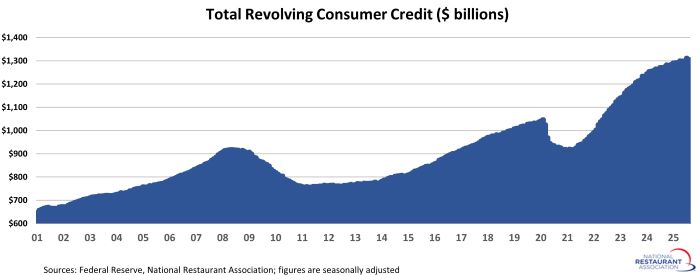
Debt service remains in check
Despite the elevated debt levels, debt service remains manageable for households on the aggregate. The Federal Reserve’s Debt Service Ratio, which is the ratio of total required household debt payments to total disposable income, was just over 11% in 2025:Q2. While that was higher than the lows posted during the first half of 2021, it remained slightly below pre-pandemic readings.
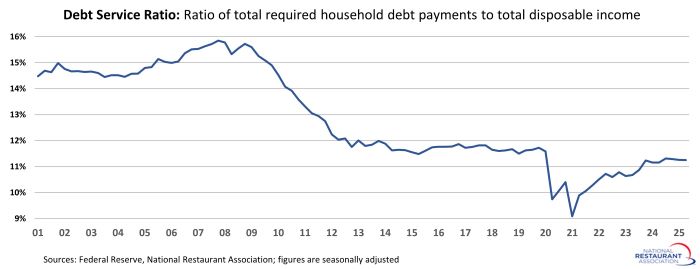
Overall delinquency rates are trending higher
While debt service levels remained manageable in historical terms, overall delinquency rates trended higher in recent quarters. As of 2025:Q2, 4.4% of outstanding household debt was in some stage of delinquency. That was up nearly 2 full percentage points from the recent low of 2.5% in 2022:Q4, and was approaching the 2019 average of 4.6%.
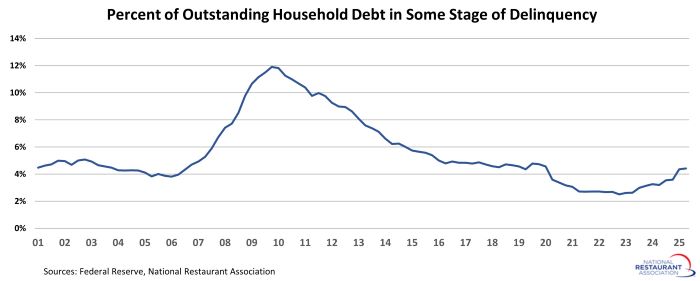
Credit card delinquencies are rising sharply
Along with an uptick in overall delinquency rates, the percentage of credit cards that were severely delinquent rose dramatically in recent quarters. As of 2025:Q2, 12.3% of credit card debt was at least 90 days delinquent. That was unchanged from 2025:Q1, which represented the first time in three years that this metric didn’t increase on a quarter-to-quarter basis. Although it leveled off, the credit card delinquency reading is up from a recent low of 7.6% in 2022:Q3 and at its highest level in 14 years.
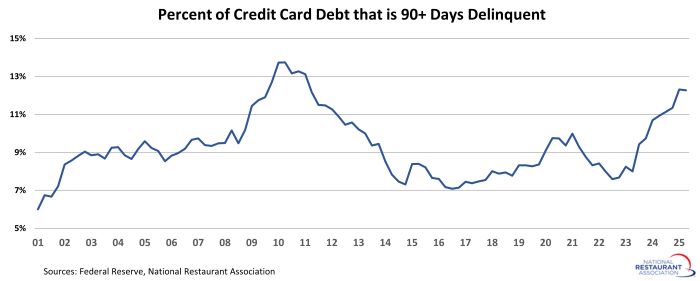
On the positive side, the national unemployment rate remains low by historical standards and there hasn’t been a significant uptick in layoffs. Still, the recent deterioration of job growth is a warning sign that a key driver of consumer activity may be losing steam.
It’s not just a slowing labor market that will test consumers’ resilience. Rising debt levels – along with an uptick in delinquency rates – will limit the ability of many households to keep spending. At the same time, household wealth keeps soaring to record levels, which will continue to buoy the confidence of consumers with homes and investments.
This story of the bifurcated consumer is nothing new, and will remain in place as the calendar flips to 2026.
As long as the economy continues to grow – which remains our base case for 2026 – consumers on the aggregate will likely have the financial wherewithal to support their spending.
This article presents the latest trends in key indicators that impact consumers’ ability and willingness to spend. Visit this page throughout the year for ongoing analysis of the state of the American consumer.
Consumer confidence remains dampened
Even before the recent slowdown in the labor market, The Conference Board’s Consumer Confidence Index showed signs of rising economic uncertainty among households. This measure of consumer sentiment declined in five consecutive months (December 2024 to April 2025) – settling at its lowest level since April 2020. That was largely due to declines in the expectations component of the index, which measures consumers’ short-term outlook for income, business, and labor market conditions. Although consumer confidence rebounded somewhat from the April low point, the index remains well below its readings at the beginning of the year. Not surprisingly, consumers on the lower end of the income scale are much less confident in the direction of the economy.

Job growth slowed significantly in recent months
Employment growth slowed to a crawl in recent months, amid rising levels of uncertainty. The economy added an average of just 27,000 jobs during the 4-month period from May to August – including a net loss of 13,000 jobs in June. That was well below the average monthly gain of 123,000 jobs during the first 4 months of 2025, and represented the weakest period of job growth since 2020.

Wage growth is slowing but remains above historical averages
Job growth slowed significantly in recent months, but wage growth remained relatively solid. Average hourly earnings of private sector employees increased 3.7% between August 2024 and August 2025. That was 2 percentage points below the strong gains posted during 2022, but still remained above the 3.3% average gain during 2019.

Savings rate dipped below pre-pandemic levels
Household savings soared during the first year and a half of the pandemic, driven primarily by reduced consumer activity as well as income-supporting fiscal stimulus packages. Many households used these excess savings to support elevated spending levels, which blunted the impact of soaring inflation. Savings rates are now below pre-pandemic levels, which means the financial cushion that many households established during the pandemic is largely depleted.

Household wealth surged in the second quarter
Household wealth declined in the first quarter of 2025, due largely to a dip in the stock market. The 1.0% decline (or $1.7 trillion) followed five consecutive quarterly gains, during which total household net worth rose by more than $18 trillion. The first quarter’s decline was more than erased in the second quarter, with household wealth surging by 4.2% – or $7.1 trillion. In dollar terms, that represented the largest quarterly increase since the fourth quarter of 2020 (+$8.2 trillion).

Household debt continues to rise
Household debt trended steadily higher in recent years, with aggregate balances reaching $18.4 trillion by 2025:Q2. That was $4.2 trillion higher than the 2019:Q4 level. Mortgages represent the bulk of household debt at 70%, followed by auto loans (9%) and student loans (9%).

Revolving credit levels continue to rise
Consumer credit balances fell to a 4-year low during the early months of the pandemic – primarily because households had fewer places to spend their money. That trend quickly reversed as restrictions eased and the economy reopened. Revolving consumer credit rose sharply during the last 4 years, which easily wiped out all of the balance reductions posted during the early months of the pandemic. By August 2025, total revolving credit balances topped $1.3 trillion, which was nearly $260 billion (or 25%) above their pre-pandemic peak.

Debt service remains in check
Despite the elevated debt levels, debt service remains manageable for households on the aggregate. The Federal Reserve’s Debt Service Ratio, which is the ratio of total required household debt payments to total disposable income, was just over 11% in 2025:Q2. While that was higher than the lows posted during the first half of 2021, it remained slightly below pre-pandemic readings.

Overall delinquency rates are trending higher
While debt service levels remained manageable in historical terms, overall delinquency rates trended higher in recent quarters. As of 2025:Q2, 4.4% of outstanding household debt was in some stage of delinquency. That was up nearly 2 full percentage points from the recent low of 2.5% in 2022:Q4, and was approaching the 2019 average of 4.6%.

Credit card delinquencies are rising sharply
Along with an uptick in overall delinquency rates, the percentage of credit cards that were severely delinquent rose dramatically in recent quarters. As of 2025:Q2, 12.3% of credit card debt was at least 90 days delinquent. That was unchanged from 2025:Q1, which represented the first time in three years that this metric didn’t increase on a quarter-to-quarter basis. Although it leveled off, the credit card delinquency reading is up from a recent low of 7.6% in 2022:Q3 and at its highest level in 14 years.
